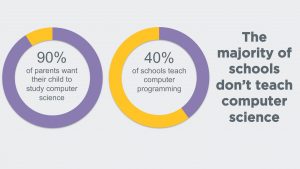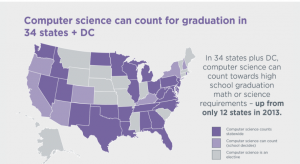Computer Science for All Schools?
Not comfortable teaching computer science? Can’t tell a bit from a byte and think Python is a snake?
Join the crowd – but not for long. States, local school districts, and the federal government are making computer science education a priority.
Why the urgency? While digital technologies have transformed how people work, play, and even learn, fewer than 25 percent of American K-12 schools currently teach computer science. The proportion is far lower in elementary and middle schools.
That’s a problem for the U.S. economy, where nearly half a million high-paying STEM jobs are open across the country – half of them in computer science-related fields.Don’t look to universities to fill the need. A new report from the National Academies of Science, Engineering and Medicine found that the growing number of jobs in the computing field far outpaces the number of students earning bachelor’s degrees in computer science and similar fields. According to the nonpartisan advocacy group Code.org, just under 43,000 computer science students graduated into the workforce last year. Already, a surge of interest in studying computer science is straining university resources.
States aren’t waiting for higher education to get cracking. In 2016, Virginia became the first state to require computer science for all K-12 students, approving new standards of learning in November. Three other states – Texas, Arkansas, and West Virginia – require all high schools to offer the subject, though it is not mandatory, and 23 states and the District of Columbia allow computer science to count toward fulfilling high school graduation requirements, according to the latest report from the Education Commission of the States. And Arizona’s governor recently secured funds to launch a statewide computer science initiative, including developing academic standards and teacher professional development.
Meanwhile, the federal government’s CS for All effort, a public-private partnership led by the National Science Foundation and U.S. Department of Education, has supported the development of such innovations as the new Advanced Placement Computer Science Principles curricular framework and CS for All Teachers, a comprehensive site with help squad, tips, events, and other resources for teaching computer science. And in September, President Trump signed a Presidential Memorandum expanding funding to promote access to high-quality STEM education, with a particular emphasis on computer science for K-12 students. Tech companies are kicking in $300 million in addition.
Schools don’t have to go it alone. Two Duke University students created an after-school program called Mobile Citizens to bring computer science to low-income middle school students. Run through Citizen Schools, a nonprofit focused on enrichment programs for low-income students, the program offers an extended apprenticeship where students develop their own mobile app.
How much of an impact such experiences have is the subject of a five-year NSF-funded study of coding camps, university led summer camps, Girls Who Code, Black Girls Code, and other informal CS programs.
High school students like Sharon Lin don’t need a study to demonstrate the impact of such opportunities. The New York high schooler was among the 2016 Congressional App Challenge winners for her iPhone application that helped users learn about candidates and issues in local and national elections, then find their polling station to exercise their franchise. It’s name: iVote.
Filed under: K-12 Education News, K-12 Outreach Programs, Special Features
Tags: Computer Science, Computer Science for All, Congressional app challenge, Public Policy, state education policy, STEM education, STEM jobs










